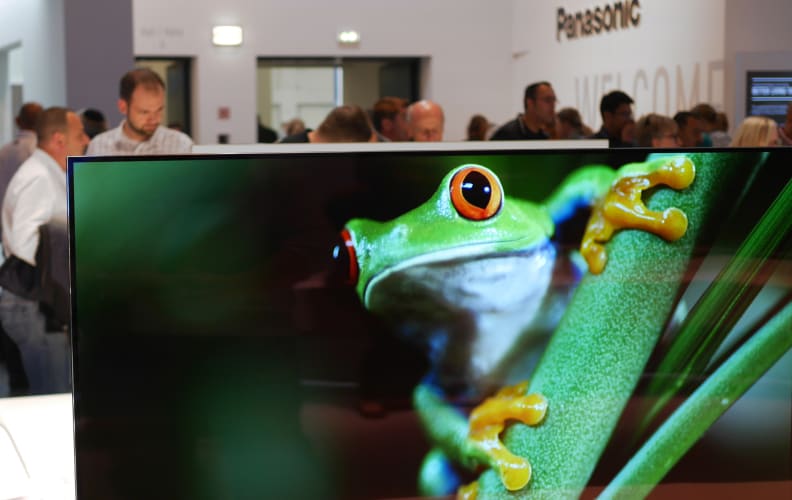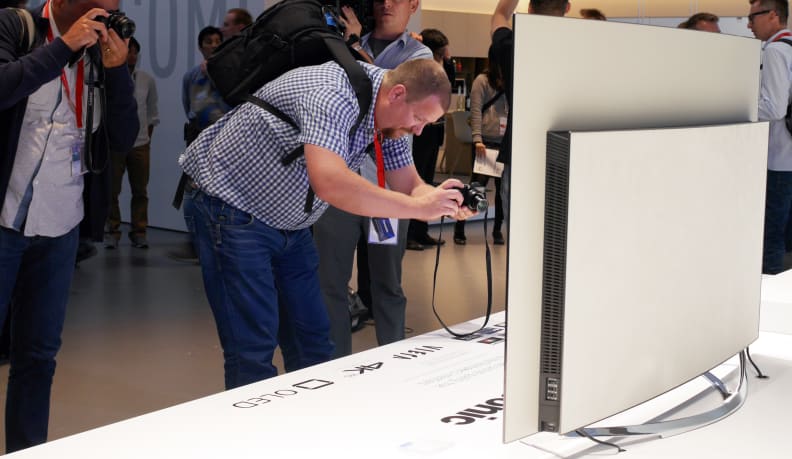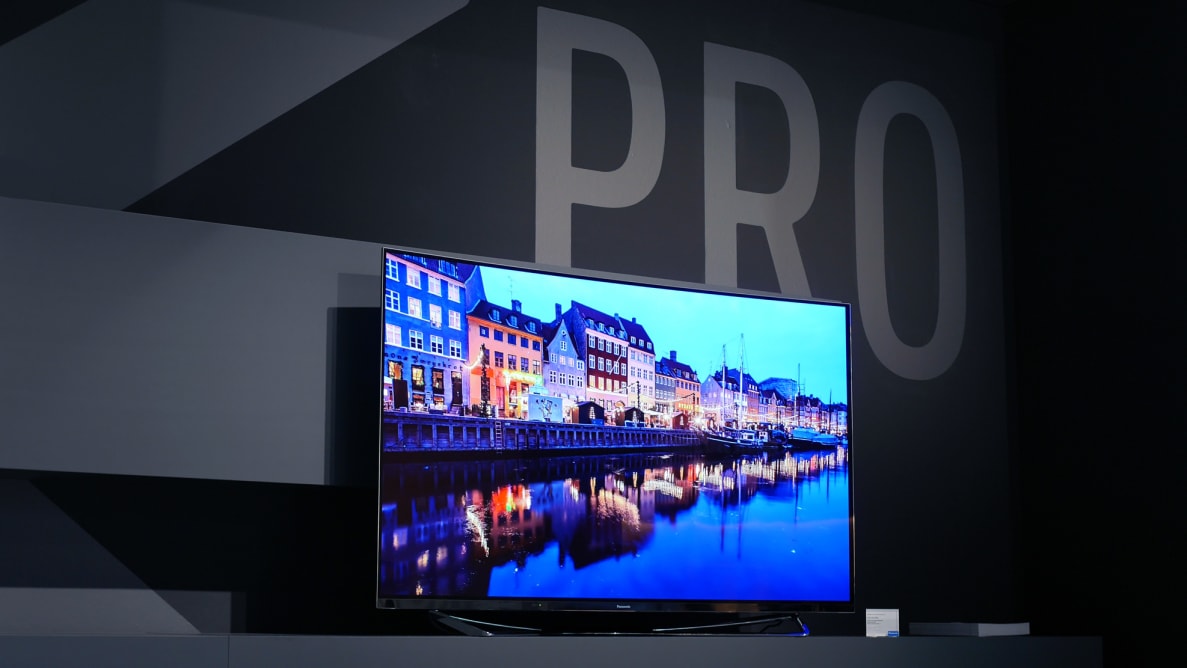Pros
Cons
Once upon a time—not so long ago, in fact—Panasonic's TV division had some swagger in its step. While it didn't lead in market share, it was responsible for some of the best TVs ever made. The secret? Plasma. Panasonic essentially cornered the market on manufacturing plasma TV panels, which were capable of producing far deeper blacks than their LCD counterparts.
Unfortunately, plasma displays didn't catch on with the average consumer. In bright retail environments, plasma's inky black levels became a negative; the sets were out-shined by brighter, flashier LCDs, despite offering better overall image quality. Plasma had other disadvantages, as well. It was heavier and more expensive than LCD, used more power, and (at first) had issues with screen burn-in.
AV nerds made the pro-plasma argument until they were blue in the face, but LCD outpaced plasma so rapidly and so definitively that Panasonic finally shuttered production in late 2013.
Since then, rumors have swirled that Panasonic is readying to exit the TV business altogether. But at IFA 2015, the company revealed its true intentions: It's been working on OLED this whole time, and now it's ready to step into the ring with LG and take back its image quality crown.
This is going to be the fight of the century.
The Spirit of Kuro
In the heyday of plasma, "everything was compared with Pioneer Kuro," said Gabor Szegner, Manager of European Product Marketing for Panasonic. The legendary Kuro plasma television was capable of hitting hitherto unknown black levels. (Indeed, the name means "black" in Japanese.) "Although it produced extremely good picture quality and black level," Szegner said, "the development cost was huge. So it wasn’t profitable."
Despite the fact that it had just a two-year run, sold poorly, and went out of production nearly half a decade ago, the Kuro plasma is still regarded by many as a high water mark for picture quality. So it shouldn't come as a surprise that Kuro was one of the first things Szegner name-dropped when talking about the new CZ950.
For Panasonic, this is a flagship with a capital "F." The TV is expected to retail for a whopping €10,000 (approximately $11,200). What could possibly justify such a price tag? Let's dive in and find out.
Oh, That OLED Panel
First, of course, is the OLED panel: 65 inches on the diagonal, 4K resolution, and a curved design.
{{amazon name="LG Electronics 55EG9600 55-inch 4K Ultra HD OLED TV (2015 Model)", asin="B00RVAGC86", align="left"}} OLED is regarded as the best display technology of our day. Each pixel generates its own light, so each pixel can individually turn off and become perfectly black. LCD panels, on the other hand, get their light either from LEDs arrayed behind the panel or strips tucked around the edges. OLED's pinpoint control of brightness gives it a huge advantage in contrast and black levels.
Panasonic refused to comment on the source of its OLED panel, but it's generally acknowledged that it couldn't have come from anywhere but LG Display. Aside from a brief foray by Samsung, LG has stood alone in the OLED category. Though the two companies will compete against each other in stores, LG is likely happy to have Panasonic selling its own OLED TVs; Panasonic's involvement helps get the OLED message out there, and will drive revenue to LG Display.
Panasonic confirmed that the panel is less curved than Samsung's competing curved TVs, which feature a highly touted 4200R bend. For its part, LG offers several 4K curved OLEDs, and in fact premiered its first flat 4K OLED here at the IFA show.
Both the panel and the processor are 10-bit. Our friends at AVS Forum recently went into a lot more detail on this subject, if you'd like to dive into the numbers.

Color management is one of the main features of the CZ950 that Panasonic is pushing in its launch messaging.
Images as the Director Intended
To make a truly great TV, you need more than just a great panel—you need great image processing. That's precisely where Panasonic's plasma pedigree comes into play, according to Szegner.
One of the biggest technical hurdles for TV makers is producing smooth, true-to-life shadow detail. "It’s really challenging to have a tiny step in blackness from absolute black," Szegner stated. "Our OLED competitors are also facing this. But because we have this plasma heritage we could add up that plasma technology into OLED development."
Unfortunately, the IFA Berlin show floor was brightly lit and surrounded by white shelving, making it about as unfavorable a viewing space as you could imagine for showing off shadow detail. The footage we saw looked great given those limitations, but we'll have to wait until the CZ950 hits our labs to make a proper evaluation.
{{amazon name="Panasonic HC-X1000 4K Ultra HD 60p/50p Professional Camcorder", asin="B00MZCCNPG", align="right"}} Still, Panasonic has done quite a job setting expectations. "Incoming brightness and outgoing brightness—if you put them in a chart—then it’s really a linear increase," Szegner explained. "So you will not see gradation steps."
Ultimately, Panasonic's goal is to reproduce images as a director intended—a tagline repeated at all levels of corporate communication. In addition to greyscale gradation levels, the CZ950 is capable of hitting about 90% of DCI color.
The CZ950, along with the CX850 (a flat, full-array backlit LCD), is part of Panasonic's so-called 4K Pro Studio Master Series, which the company says is distinguished by its mastery over color. The magic behind the superior processing is allegedly found in a 3D lookup table (LUT) that analyzes the primary and secondary colors: red, green, and blue, along with cyan, yellow, and magenta.
It was impossible to put these claim to the test during the show, but we can verify that Panasonic TVs have historically produced excellent color accuracy in our labs. The company's final plasma, the ZT60 was also its best, boasting nearly perfect color performance.

The CZ950 is super thin at the edges.
Is that leather?
A great deal of attention has been paid to the exterior design of the CZ950—particularly the back, which typically sees about as much action as the underside of your bed. This is a TV that wants to be seen from all angles.
The back panel is partially covered in Alcantara, a fuzzy, suede-like material used in high-end cars and furniture. While durability was highlighted as one of its key features, I can’t imagine why the backside of a television needs added durability. But with that said, the effect is undeniably pleasant.
As noted above, the TV is also gently curved and extremely thin along the edge, which puts it in line with the other high-end showpiece TVs on the market today. Maybe some of the Technics designers were in the room when the CX950 was being sketched out.

The Panasonic CZ950 has genuine Alcantara on it. (Don't worry, we had to look it up, too.)
The Takeaway
The Panasonic CZ950 is easily one of the most exciting TVs to be announced in some time.
Why? Well, most of Reviewed.com’s top-rated TVs are OLED sets. Couple that fact with Panasonic’s characteristically firm commitment to color accuracy and greyscale processing, and you have the recipe for what could very well be the new best in class.
But just what class does a €10,000 TV fall into? For most, it's the one you don’t buy, but read about. (You know, like you’re doing right now.) This is a TV that thousands will praise and criticize on internet forums, based purely on spec sheets, but few will ever lay eyes on. But it's also a halo product, whose best features will eventually trickle down to more mundane, affordable descendants.
Maybe a halo product is what Panasonic needs right now, anyway. Abandoning plasma had to be a humbling moment for the company, which had the best technology but was powerless in the face of greater economic forces. The CZ950 may not generate many sales, but it could bring notoriety back to one of TV's biggest names, and help move some of its more accessible products (namely, the CX850).
Until then, we’ll have to settle for this beautiful unicorn.
Related Video
{{brightcove '4467071689001'}}
Meet the tester
David Kender oversees content at Reviewed as the Editor in Chief. He served as managing editor and editor in chief of Reviewed's ancestor, CamcorderInfo.com, helping to grow the company from a tiny staff to one of the most influential online review resources. In his time at Reviewed, David has helped to launch over 100 product categories and written too many articles to count.
Checking our work.
Our team is here to help you buy the best stuff and love what you own. Our writers, editors, and experts obsess over the products we cover to make sure you're confident and satisfied. Have a different opinion about something we recommend? Email us and we'll compare notes.
Shoot us an email

